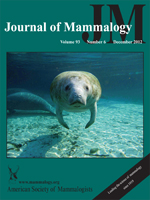We examined population density of Oligoryzomys longicaudatus (colilargo) and prevalence of Andes virus (ANDV) antibody at regional and landscape spatial scales in northwestern Chubut Province (Argentina) and contrasted it with climatic variables recorded by meteorologic stations near the study area. Mice were trapped in late summer–early fall (March–April) for 3 years (2007–2009). The composition of the rodent assemblage and species representation in the community varied among years, regions (forest, ecotone, and steppe), and landscape units (Nothofagus and Austrocedrus forests, sweet briar shrublands, and without sweet briar shrublands). Colilargos occurred in all regions and landscape units within the study area, from dense forest to open habitats such as steppe. The species dominated the rodent assemblages of ecotone and forest at a regional scale and the assemblages in sweet briar shrublands and Austrocedrus forests at a landscape scale. Abundance of colilargos also varied among periods, regions, and landscape units. Antibodies to ANDV were found in all regions but not in every landscape unit. Thus there is a potential for human hantavirus pulmonary syndrome (HPS) cases to occur not only in forests and shrublands, but also in steppe. At a landscape scale, Nothofagus forests appeared to pose a higher risk than Austrocedrus in wet years, because colilargo abundance and ANDV antibody prevalence were significantly greater. Within ecotone, sweet briar shrublands posed greater risk than habitats without sweet briar. Sweet briar shrublands were the landscape unit with the highest colilargo abundances during the driest periods. Sweet briar shrublands may play an important role in HPS dynamics, and should be considered when designing prevention policies.
Nuestro objetivo fue examinar la densidad poblacional de Oligoryzomys longicaudatus (colilargo) y la prevalencia de virus Andes (ANDV) a escala regional y de paisaje en el noroeste de la provincia de Chubut, Argentina. Los muestreos se llevaron a cabo durante el verano tardío–otoño temprano (Marzo–Abril) por un período de 3 años (2007 a 2009). La composición de la comunidad de roedores y la representación de cada especie en la misma varió entre años, regiones (bosque, ecotono y estepa) y unidades de paisaje (bosques de Nothofagus y de Austrocedrus, matorrales de rosa mosqueta y matorrales sin rosa mosqueta). O. longicaudatus fue encontrado en todas las regiones y unidades de paisaje del área de estudio. Esta especie dominó los ensambles de roedores de bosques y ecotono a escala regional y los ensambles de los matorrales de rosa mosqueta y bosques de Austrocedrus a escala de paisaje. La abundancia de colilargos varió entre períodos, regiones y unidades de paisaje. Se detectaron anticuerpos contra ANDV en todas las regiones, pero no en todas las unidades de paisaje. Por lo tanto, el riesgo de enfermedad en humanos existe no sólo en bosque y ecotono, sino también en estepa. Además, a escala de paisaje, los bosques de Nothofagus parecieron implicar un mayor riesgo que los de Austrocedrus en años húmedos, ya que las abundancias de colilargos y la prevalencia de ANDV fueron significativamente mayores en los primeros. Dentro del ecotono, los matorrales de rosa mosqueta significaron un mayor riesgo que los matorrales sin rosa mosqueta. Los primeros constituyeron la unidad de paisaje con las mayores abundancias de colilargos durante los períodos secos. Estos matorrales podrían tener un papel importante en la dinámica del Síndrome Pulmonar por Hantavirus y debieran ser considerados a la hora de diseñar medidas de prevención.





